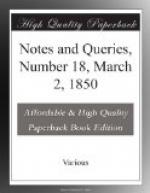Phoenix—by Lactantius.—“Seleucus” is informed, in answer to his query in No. 13. p. 203., that he will find the Latin poem of the Phoenix, in hexameters and pentameters, in that scarce little volume, edited by Pithaeus, and published at Paris in 1590 (see Brunet), Epigrammata et Poematia Vetera, &c. (of which I am happy to say I possess a most beautiful copy), where it is headed “Phoenix, Incerti Auctoris;” and again at the end of the edition of Claudian by P. Burmann Secundus Amsterdam, 1760), with the following title,—Lactantia Elegia, de Phoenice; vulgo Claudiano ad scripta, &c., where also another correspondent, “R.G.” (in No. 15. p. 235.), will find much information as to who was the author of the poem.
C.J.C.
Feb. 9. 1850.
Catsup (no. 8. p. 125.).—“Catsup” is to be found thus spelt in Todd’s Johnson’s Dictionary (London, 1818). He describes it as a kind of Indian pickles imitated by pickled mushrooms; and quotes these two lines of Swift:
“And for our home-bred British cheer,
Botargo, catsup, and cavier.”
An eminnet Sanscrit scholar informs me that “kuck-hup” is the Hindostanee word for Turtle; it is to be met in the Vocabulary attached to Gilchrist’s East Indian Guide (8vo. London, 1820). May not the name of the sauce take its origin from the use of it in preparing the turtle for the table? In the Cuisinier Royal, par Viart, p. 75., it is mentioned among the “petites sauces,” as ket-chop, “ou Soyac;” and the receipt for making it ends with “servez le avec le poisson.” (Published at Paris, 1840.)
C.I.R.
The Buckingham Motto (No. 9. p. 138., and No. 16. p. 252.).—On examining the original manuscript the true reading of this motto appears to me to be,
Sovente me sovene,
Harre Bokynghame.
I should translate it, “souvent me souvenez;” an Anglo-French paraphrase of “sis memor mei;” or, “Ne m’oubliez pas.” I have great doubt {284} whether the original MS. can be safely assumed to be an autograph.
S.
[Our correspondent “P.”
writes, “It surprises me your OEdipi
should be so wide of the mark
in this motto. It is simply, ’Oft
remember me.’”]
Devices of the Standards of the Anglo-Saxons (No. 14. p. 216.).—The arms, i.e. the standards of the successive rulers of Britain, may be found in Sir Winston Churchill’s curious work, Divi Britannici, which gives (as your correspondent supposes) the White Horse for Kent, the White Dragon for Wessex, and the Raven for the Danes.
C.
Prutenicae (No. 14. p. 215.).—The work to which your correspondent alludes is, I presume, Prutenicae Tabulae Caelestium Motuum, autore Erasmo Reinholdo: Tubingae, 1562. This work is dedicated to Albert, Duke of Prussia. In the dedication is the following passage:




